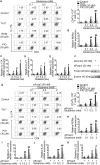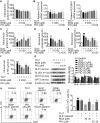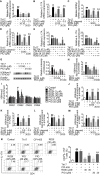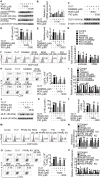The role of GLS1-mediated glutaminolysis/2-HG/H3K4me3 and GSH/ROS signals in Th17 responses counteracted by PPARγ agonists
- PMID: 33754076
- PMCID: PMC7977454
- DOI: 10.7150/thno.54803
The role of GLS1-mediated glutaminolysis/2-HG/H3K4me3 and GSH/ROS signals in Th17 responses counteracted by PPARγ agonists
Abstract
Background: Peroxisome proliferator-activated receptor gamma (PPARγ) has the ability to counter Th17 responses, but the full mechanisms remain elusive. Herein, we aimed to elucidate this process in view of cellular metabolism, especially glutaminolysis. Methods: MTT, CCK-8, Annexin V-FITC/PI staining or trypan blue exclusion assays were used to analyze cytotoxicity. Flow cytometry and Q-PCR assays were applied to determine Th17 responses. The detection of metabolite levels using commercial kits and rate-limiting enzyme expression using western blotting assays was performed to illustrate the metabolic activity. ChIP assays were used to examine H3K4me3 modifications. Mouse models of dextran sulfate sodium (DSS)-induced colitis and house dust mite (HDM)/lipopolysaccharide (LPS)-induced asthma were established to confirm the mechanisms studied in vitro. Results: The PPARγ agonists rosiglitazone and pioglitazone blocked glutaminolysis but not glycolysis under Th17-skewing conditions, as indicated by the detection of intracellular lactate and α-KG and the fluorescence ratios of BCECF-AM. The PPARγ agonists prevented the utilization of glutamine and thus directly limited Th17 responses even when Foxp3 was deficient. The mechanisms were ascribed to restricted conversion of glutamine to glutamate by reducing the expression of the rate-limiting enzyme GLS1, which was confirmed by GLS1 overexpression. Replenishment of α-KG and 2-HG but not succinate weakened the effects of PPARγ agonists, and α-KG-promoted Th17 responses were dampened by siIDH1/2. Inhibition of KDM5 but not KDM4/6 restrained the inhibitory effect of PPARγ agonists on IL-17A expression, and the H3K4me3 level in the promoter and CNS2 region of the il-17 gene locus down-regulated by PPARγ agonists was rescued by 2-HG and GLS1 overexpression. However, the limitation of PPARγ agonists on the mRNA expression of RORγt was unable to be stopped by 2-HG but was attributed to GSH/ROS signals subsequent to GLS1. The exact role of PPARγ was proved by GW9662 or PPARγ knockout, and the mechanisms for PPARγ-inhibited Th17 responses were further confirmed by GLS1 overexpression in vivo. Conclusion: PPARγ agonists repressed Th17 responses by counteracting GLS1-mediated glutaminolysis/2-HG/H3K4me3 and GSH/ROS signals, which is beneficial for Th17 cell-related immune dysregulation.
Keywords: PPARγ; Th17 responses; glutaminase 1; glutaminolysis.
© The author(s).
Conflict of interest statement
Competing Interests: The authors have declared that no competing interest exists.
Figures









Similar articles
-
Bergenin, a PPARγ agonist, inhibits Th17 differentiation and subsequent neutrophilic asthma by preventing GLS1-dependent glutaminolysis.Acta Pharmacol Sin. 2022 Apr;43(4):963-976. doi: 10.1038/s41401-021-00717-1. Epub 2021 Jul 15. Acta Pharmacol Sin. 2022. PMID: 34267342 Free PMC article.
-
Glutaminase 1 Inhibition Reduces Glycolysis and Ameliorates Lupus-like Disease in MRL/lpr Mice and Experimental Autoimmune Encephalomyelitis.Arthritis Rheumatol. 2019 Nov;71(11):1869-1878. doi: 10.1002/art.41019. Epub 2019 Sep 27. Arthritis Rheumatol. 2019. PMID: 31233276 Free PMC article.
-
GLS1-mediated glutaminolysis unbridled by MALT1 protease promotes psoriasis pathogenesis.J Clin Invest. 2020 Oct 1;130(10):5180-5196. doi: 10.1172/JCI129269. J Clin Invest. 2020. PMID: 32831293 Free PMC article.
-
Targeting GLS1 to cancer therapy through glutamine metabolism.Clin Transl Oncol. 2021 Nov;23(11):2253-2268. doi: 10.1007/s12094-021-02645-2. Epub 2021 May 23. Clin Transl Oncol. 2021. PMID: 34023970 Review.
-
Harnessing peroxisome proliferator-activated receptor γ agonists to induce Heme Oxygenase-1: a promising approach for pulmonary inflammatory disorders.Cell Commun Signal. 2024 Feb 15;22(1):125. doi: 10.1186/s12964-024-01501-4. Cell Commun Signal. 2024. PMID: 38360670 Free PMC article. Review.
Cited by
-
Mechanism and application of lactylation in cancers.Cell Biosci. 2025 Jun 4;15(1):76. doi: 10.1186/s13578-025-01415-9. Cell Biosci. 2025. PMID: 40468447 Free PMC article. Review.
-
Morin, the PPARγ agonist, inhibits Th17 differentiation by limiting fatty acid synthesis in collagen-induced arthritis.Cell Biol Toxicol. 2023 Aug;39(4):1433-1452. doi: 10.1007/s10565-022-09769-3. Epub 2022 Sep 19. Cell Biol Toxicol. 2023. PMID: 36121554
-
Artesunate targets cellular metabolism to regulate the Th17/Treg cell balance.Inflamm Res. 2023 May;72(5):1037-1050. doi: 10.1007/s00011-023-01729-9. Epub 2023 Apr 6. Inflamm Res. 2023. PMID: 37024544 Review.
-
Xiaoyankangjun tablet alleviates dextran sulfate sodium-induced colitis in mice by regulating gut microbiota and JAK2/STAT3 pathway.Nat Prod Bioprospect. 2024 Aug 12;14(1):44. doi: 10.1007/s13659-024-00468-6. Nat Prod Bioprospect. 2024. PMID: 39133435 Free PMC article.
-
PPAR-γ alleviates the inflammatory response in TNF-α-induced fibroblast-like synoviocytes by binding to p53 in rheumatoid arthritis.Acta Pharmacol Sin. 2023 Feb;44(2):454-464. doi: 10.1038/s41401-022-00957-9. Epub 2022 Aug 2. Acta Pharmacol Sin. 2023. PMID: 35918412 Free PMC article.
References
-
- Jiang Y, Wang X, Dong C. Molecular mechanisms of T helper 17 cell differentiation: Emerging roles for transcription cofactors. Adv Immunol. 2019;144:121–153. - PubMed
-
- de Oliveira Boldrini V, Dos Santos Farias A, Degasperi GR. Deciphering targets of Th17 cells fate: From metabolism to nuclear receptors. Scand J Immunol. 2019;90:e12793. - PubMed
-
- Leppkes M, Becker C, Ivanov II, Hirth S, Wirtz S, Neufert C. et al. RORgamma-expressing Th17 cells induce murine chronic intestinal inflammation via redundant effects of IL-17A and IL-17F. Gastroenterology. 2009;136:257–267. - PubMed
-
- Chenuet P, Fauconnier L, Madouri F, Marchiol T, Rouxel N, Ledru A. et al. Neutralization of either IL-17A or IL-17F is sufficient to inhibit house dust mite induced allergic asthma in mice. Clin Sci (Lond) 2017;131:2533–2548. - PubMed
Publication types
MeSH terms
Substances
LinkOut - more resources
Full Text Sources
Other Literature Sources
Research Materials
Miscellaneous

